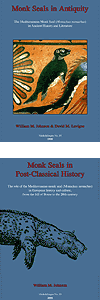Recent Publications
![]() Dirk-Martin Scheel, Graham Slater, Sergios-Orestis Kolokotronis, Charles Potter, David Rotstein, Kyriakos Tsangaras, Alex Greenwood and Kristofer M. Helgen. 2014. Biogeography and taxonomy of extinct and endangered monk seals illuminated by ancient DNA and skull morphology, ZooKeys 409 (2014): 1-33. [Downloadable in various formats from Zookeys]
Dirk-Martin Scheel, Graham Slater, Sergios-Orestis Kolokotronis, Charles Potter, David Rotstein, Kyriakos Tsangaras, Alex Greenwood and Kristofer M. Helgen. 2014. Biogeography and taxonomy of extinct and endangered monk seals illuminated by ancient DNA and skull morphology, ZooKeys 409 (2014): 1-33. [Downloadable in various formats from Zookeys]
Abstract
Extinctions and declines of large marine vertebrates have major ecological impacts and are of critical concern in marine environments. The Caribbean monk seal, Monachus tropicalis, last definitively reported in 1952, was one of the few marine mammal species to become extinct in historical times. Despite its importance for understanding the evolutionary biogeography of southern phocids, the relationships of M. tropicalis to the two living species of critically endangered monk seals have not been resolved. In this study we present the first molecular data for M. tropicalis, derived from museum skins. Phylogenetic analysis of cytochrome b sequences indicates that M. tropicalis was more closely related to the Hawaiian rather than the Mediterranean monk seal. Divergence time estimation implicates the formation of the Panamanian Isthmus in the speciation of Caribbean and Hawaiian monk seals. Molecular, morphological and temporal divergence between the Mediterranean and “New World monk seals” (Hawaiian and Caribbean) is profound, equivalent to or greater than between sister genera of phocids. As a result, we classify the Caribbean and Hawaiian monk seals together in a newly erected genus, Neomonachus. The two genera of extant monk seals (Monachus and Neomonachus) represent old evolutionary lineages each represented by a single critically endangered species, both warranting continuing and concerted conservation attention and investment if they are to avoid the fate of their Caribbean relative.


 The Aquatic Mammals special edition on Mediterranean and Hawaiian monk seals, whose publication was announced with some excitement in September last year, has finally been made available for public purchase. As far as we can ascertain, those unlucky enough not to have institutional access or public libraries with AA subscriptions, will be paying $12 for each paper they choose to purchase. One author, Giulia Mo (listed below) has, however, asked us to inform interested readers that she will email copies of her paper free of charge to those who request it. Please contact:
The Aquatic Mammals special edition on Mediterranean and Hawaiian monk seals, whose publication was announced with some excitement in September last year, has finally been made available for public purchase. As far as we can ascertain, those unlucky enough not to have institutional access or public libraries with AA subscriptions, will be paying $12 for each paper they choose to purchase. One author, Giulia Mo (listed below) has, however, asked us to inform interested readers that she will email copies of her paper free of charge to those who request it. Please contact:  Seeking a more effective model in reporting the challenges affecting conservation of the Mediterranean and Hawaiian monk seals, we have decided to cease publication of The Monachus Guardian as a biannual journal. Perhaps inevitably in this age of cutbacks, lack of funding for the Guardian also proved a contributing factor.
Seeking a more effective model in reporting the challenges affecting conservation of the Mediterranean and Hawaiian monk seals, we have decided to cease publication of The Monachus Guardian as a biannual journal. Perhaps inevitably in this age of cutbacks, lack of funding for the Guardian also proved a contributing factor.